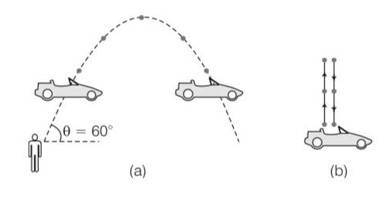A boy throws a ball in air at 60° to the horizontal along a road with a speed of 10 m/s (36km/h). Another boy sitting in a passing by car observes the ball. Sketch the motion of the ball as observed by the boy in the car, if car has a speed of (18km/h). Give explanation to support your diagram.
A boy throws a ball in air at 60° to the horizontal along a road with a speed of 10 m/s (36km/h). Another boy sitting in a passing by car observes the ball. Sketch the motion of the ball as observed by the boy in the car, if car has a speed of (18km/h). Give explanation to support your diagram.
-
1 Answer
-
This is a Short Answer Type Questions as classified in NCERT Exemplar
Explanation – The boy throws the ball at an angle of 60.

Horizontal component of velocity 4cos = 10cos60
=10 (1/2)
=5m/s.
so horizontal speed of the car is same, hence relative velocity of car and ball in the horizontal direction will be zero.
Similar Questions for you
There are two types of electricity - static and current. The current electricity is divided into Alternating Current (AC) and Direct Current (DC). Based on the production methods, electricity is divided into - heat, chemical, pressure, light and magnetism.
There are four types of power supply - switch-mode power supplies, linear power supplies, linear power supplies, and programmable power supplies
According to this law, at any point, magnetic field due to a tiny current element is directly proportional to the current element length.
Tesla (T) is the SI unit of magnetic field. Tesla is named after Nikola Tesla.
The different types of magnetism are - Diamagnetism, Paramagnetism, and Ferromagnetism.
Taking an Exam? Selecting a College?
Get authentic answers from experts, students and alumni that you won't find anywhere else
Sign Up on ShikshaOn Shiksha, get access to
- 65k Colleges
- 1.2k Exams
- 679k Reviews
- 1800k Answers
